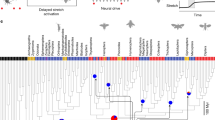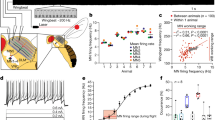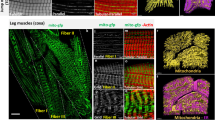Abstract
Flight in insects—which constitute the largest group of species in the animal kingdom—is powered by specialized muscles located within the thorax. In most insects each contraction is triggered not by a motor neuron spike but by mechanical stretch imposed by antagonistic muscles1. Whereas ‘stretch activation’ and its reciprocal phenomenon ‘shortening deactivation’ are observed to varying extents in all striated muscles, both are particularly prominent in the indirect flight muscles of insects1. Here we show changes in thick-filament structure and actin–myosin interactions in living, flying Drosophila with the use of synchrotron small-angle X-ray diffraction. To elicit stable flight behaviour and permit the capture of images at specific phases within the 5-ms wingbeat cycle, we tethered flies within a visual flight simulator2. We recorded images of 340 µs duration every 625 µs to create an eight-frame diffraction movie, with each frame reflecting the instantaneous structure of the contractile apparatus. These time-resolved measurements of molecular-level structure provide new insight into the unique ability of insect flight muscle to generate elevated power at high frequency.
This is a preview of subscription content, access via your institution
Access options
Subscribe to this journal
Receive 51 print issues and online access
$199.00 per year
only $3.90 per issue
Buy this article
- Purchase on Springer Link
- Instant access to full article PDF
Prices may be subject to local taxes which are calculated during checkout



Similar content being viewed by others
References
Josephson, R., Malamud, J. & Stokes, D. Asynchronous muscle: a primer. J. Exp. Biol. 203, 2713–2722 (2000)
Lehmann, F. O. & Dickinson, M. H. The changes in power requirements and muscle efficiency during elevated force production in the fruit fly Drosophila melanogaster . J. Exp. Biol. 200, 1133–1143 (1997)
Reedy, M. K., Holmes, K. C. & Tregear, R. T. Induced changes in orientation of the cross-bridges of glycerinated insect flight muscle. Nature 207, 1276–1280 (1965)
Miller, A. & Tregear, R. T. Evidence concerning crossbridge attachment during muscle contraction. Nature 226, 1060–1061 (1970)
Tregear, R. T. et al. X-ray diffraction indicates that active cross-bridges bind to actin target zones in insect flight muscle. Biophys. J. 74, 1439–1451 (1998)
al-Khayat, H. A., Yagi, N. & Squire, J. M. Structural changes in actin-tropomyosin during muscle regulation: computer modelling of low-angle X-ray diffraction data. J. Mol. Biol. 252, 611–632 (1995)
Reedy, M. K. & Reedy, M. C. Rigor crossbridge structure in tilted single filament layers and flared-X formations from insect flight muscle. J. Mol. Biol. 185, 145–176 (1985)
Taylor, K. A. et al. Tomographic 3D reconstruction of quick-frozen, Ca2+-activated contracting insect flight muscle. Cell 99, 421–431 (1999)
Reedy, M. C. Visualizing myosin's power stroke in muscle contraction. J. Cell Sci. 113, 3551–3562 (2000)
Irving, T. C. & Maughan, D. W. In vivo x-ray diffraction of indirect flight muscle from Drosophila melanogaster . Biophys. J. 78, 2511–2515 (2000)
Huxley, H. E. et al. Changes in the X-ray reflections from contracting muscle during rapid mechanical transients and their structural implications. J. Mol. Biol. 169, 469–506 (1983)
Irving, M., Lombardi, V., Piazzesi, G. & Ferenczi, M. A. Myosin head movements are synchronous with the elementary force-generating process in muscle. Nature 357, 156–158 (1992)
Irving, M. et al. Conformation of the myosin motor during force generation in skeletal muscle. Nature Struct. Biol. 7, 482–485 (2000)
Huxley, H. E., Stewart, A. & Irving, T. Spacing changes in the actin and myosin filaments during activation, and their implications. Adv. Exp. Med. Biol. 453, 281–288 (1998)
Huxley, H. E., Reconditi, M., Stewart, A. & Irving, T. What the higher order meridional reflections tell us. Biophys. J. 84, 139a (2003)
Chan, W. P. & Dickinson, M. H. In vivo length oscillations of indirect flight muscles in the fruit fly Drosophila virilis . J. Exp. Biol. 199, 2767–2774 (1996)
Wakabayashi, K. et al. X-ray diffraction evidence for the extensibility of actin and myosin filaments during muscle contraction. Biophys. J. 67, 2422–2435 (1994)
Weis-Fogh, T. in XV Int. Congr. Entomol. (Royal Entomological Society, London, 8 to 16 July 1964) (ed. Freeman, P.) 186–188 (XII International Congress of Entomology, London, 1965)
Alexander, R. M. & Bennet-Clark, H. C. Storage of elastic strain energy in muscle and other tisues. Nature 265, 380–390 (1977)
Dickinson, M. H. & Lighton, J. R. Muscle efficiency and elastic storage in the flight motor of Drosophila . Science 268, 87–90 (1995)
Menetret, J. F., Schroder, R. R. & Hofmann, W. Cryo-electron microscopic studies of relaxed striated muscle thick filaments. J. Muscle Res. Cell Motil. 11, 1–11 (1990)
Dobbie, I. et al. Elastic bending and active tilting of myosin heads during muscle contraction. Nature 396, 383–387 (1998)
Squire, J. M. The Structural Basis of Muscular Contraction (Plenum, New York, 1981)
Linari, M., Reedy, M. K., Reedy, M. C., Lombardi, V. & Piazzesi, G. Ca-activation and stretch-activation in insect flight muscle. Biophys. J. 87, 1101–1111 (2004)
Agianian, B. et al. A troponin switch that regulates muscle contraction by stretch instead of calcium. EMBO J. 23, 772–779 (2004)
Tregear, R. T. et al. Cross-bridge number, position, and angle in target zones of cryofixed isometrically active insect flight muscle. Biophys. J. 86, 3009–3019 (2004)
Juanhuix, J. et al. Axial disposition of myosin heads in isometrically contracting muscles. Biophys. J. 80, 1429–1441 (2001)
Littlefield, K. P. et al. The converter domain modulates kinetic properties of Drosophila myosin. Am. J. Physiol. Cell Physiol. 284, C1031–C1038 (2003)
Sparrow, J., Drummond, D., Peckham, M., Hennessey, E. & White, D. Protein engineering and the study of muscle contraction in Drosophila flight muscles. J. Cell Sci. Suppl. 14, 73–78 (1991)
Irving, T. C., Fischetti, R. F., Rosenbaum, G. & Bunker, G. B. Fiber diffraction using the BioCAT Undulator Beamline at the Advanced Photon Source. Nucl. Instrum. Methods A 448, 250–254 (2000)
Acknowledgements
We thank J. Costello for help with data analysis, J. Fockler for computer programming, and D. Swank, R. Tregear, M. K. Reedy and M. C. Reedy for helpful discussions. The research was supported by NIH. The APS is supported by the US Department of Energy. BioCAT is a NIH-supported Research Center.
Author information
Authors and Affiliations
Corresponding author
Ethics declarations
Competing interests
The authors declare that they have no competing financial interests.
Supplementary information
Supplementary Video 1
Changes in X-ray diffraction patterns during a wingbeat. Animation consisting of background subtracted X-ray diffraction patterns from live Drosophila metleri at each time point in the wingbeat cycle along with cartoons showing wing position and relative length of the DLMs and DVMs (length changes exaggerated 10-fold). Initially 2 s per frame and then 10 wingbeats/8s (MOV 5893 kb)
Rights and permissions
About this article
Cite this article
Dickinson, M., Farman, G., Frye, M. et al. Molecular dynamics of cyclically contracting insect flight muscle in vivo. Nature 433, 330–334 (2005). https://doi.org/10.1038/nature03230
Received:
Accepted:
Issue Date:
DOI: https://doi.org/10.1038/nature03230
This article is cited by
-
Gap junctions desynchronize a neural circuit to stabilize insect flight
Nature (2023)
-
Bridging two insect flight modes in evolution, physiology and robophysics
Nature (2023)
-
Paradoxes of Hymenoptera flight muscles, extreme machines
Biophysical Reviews (2022)
-
Vortex trapping recaptures energy in flying fruit flies
Scientific Reports (2021)
-
Flight of the bumblebee decoded
Nature (2013)
Comments
By submitting a comment you agree to abide by our Terms and Community Guidelines. If you find something abusive or that does not comply with our terms or guidelines please flag it as inappropriate.



